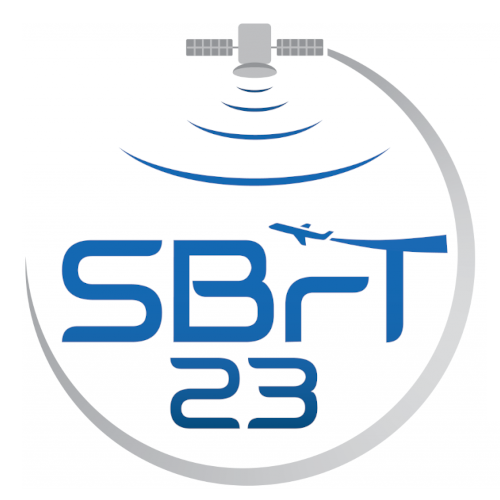
XLI Simpósio Brasileiro de Telecomunicações e Processamento de Sinais
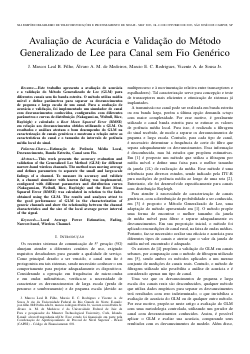
Avaliação de Acurácia e Validação do Método Generalizado de Lee para Canal sem Fio Genérico
José Marcos Leal Barbosa Filho, Álvaro A. M. de Medeiros, Marcio E. C. Rodrigues, Vicente Sousa
DOI: 10.14209/sbrt.2023.1570916788
Keywords: Local Average Power Estimation Fading Narrow-band Wireless Channel
Abstract
This work presents the accuracy evaluation and validation of the Generalized Lee Method (GLM) for different narrow-band wireless channels. The method uses moving average and defines parameters to separate the small and large-scale fadings of a channel. To measure its accuracy and validate it, a channel simulator with known fading was implemented, configured with different parameters and distribution curves (Nakagami-m, Weibull, Rice, Rayleigh) and the Root Mean Squared Error (RMSE) was calculated in relation to the fades obtained using the GLM. The results and analyzes attest to the good performance of GLM in the characterization of generic channels and show the relationship between the channel characteristics and the size of the local average power interval of the signal.Download
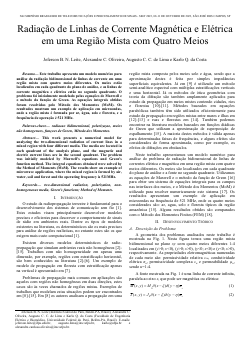
Radiação de Linhas de Corrente Magnética e Elétrica em uma Região Mista com Quatro Meios
Karlo Queiroz Costa, Alexandre Oliveira, Augusto C Lima, Jeferson Breno Negrao Leite
DOI: 10.14209/sbrt.2023.1570916819
Keywords: radiacao bidimensional polarizaçao meios não homogeneos funçoes de Green
Abstract
This work presents a numerical model for analyzing the two-dimensional radiation of current lines in a mixed region with four different media. The media are located in each quadrant of the analysis plane, and the magnetic and electric current lines are in the second quadrant. The problem was initially modeled by Maxwell's equations and Green's function method. The integral equations obtained were solved by the Method of Moments (MoM). The results show an example of microwave application, where the mixed region is formed by air, water, soil and forest and the operating frequency is 521MHz.Download

A Transformada Quaterniônica de Fourier sobre Grafos
Guilherme Ribeiro, Juliano B. Lima, José R. de Oliveira Neto
DOI: 10.14209/sbrt.2023.1570917488
Keywords: Processamento de sinais sobre grafos Quatérnios Transformada de Fourier Compressão de dados
Abstract
Neste artigo, amplia-se o escopo usual do processamento de sinais sobre grafos, considerando sinais quaterniônicos sobre grafos com pesos de arestas também quaterniônicos. A abordagem proposta parte da definição de uma transformada quaterniônica de Fourier em grafos (QGFT), cujo cálculo envolve o encadeamento de vários resultados da álgebra dos quatérnios. O ferramental introduzido permite tratar holisticamente sinais multivariados sobre grafos, em vez de tratá-los como sinais reais independentes. Por meio de experimentos envolvendo a compressão de dados do mundo real, demonstra-se que o uso da QGFT na aplicação em questão pode prover vantagens em comparação com o uso de sua versão não-quaterniônica.Download
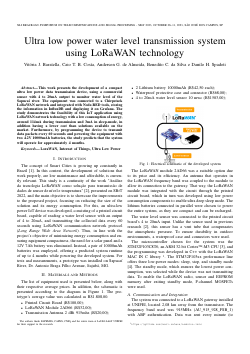
Ultra low power water level transmission system using LoRaWAN technology
Vitória Jacomelli Baratella, Caio Tácito Borges da Costa, Danilo Spadoti, Anderson Guerra Almeida, Benedito C. da Silva
DOI: 10.14209/sbrt.2023.1570917497
Keywords: LoraWAN Internet of Things Ultra Low Power
Abstract
This work presents the development of a compact ultra low power data transmission device, using a commercial sensor with 4 to 20mA output to monitor water level of the Sapucaí river. The equipment was connected to a Chirpstack LoRaWAN network and integrated with Node-RED tools, storing the information in InfluxDB and displaying it on Grafana. The study demonstrates the feasibility of this IoT application using LoRaWAN network technology with a low consumption of energy, around 114mA during transmission and 3mA in sleep-mode, in addition to having a lower cost than solutions available on the market. Furthermore, by programming the device to transmit data packets every 60 seconds and powering the equipment with two 4.2V 10000mAh batteries, the study predicts that the system will operate for approximately 4 months.Download
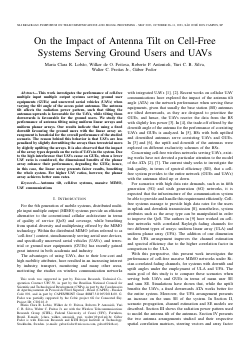
On the Impact of Antenna Tilt on Cell-Free Systems Serving Ground Users and UAVs
Maria Clara R. Lobão, Wilker de O Feitosa, Roberto P. Antonioli, Yuri C. B. Silva, Walter da Cruz Freitas Jr., Gabor Fodor
DOI: 10.14209/sbrt.2023.1570917523
Keywords: Antenna Tilt Cell-free systems Massive MIMO UAV communications
Abstract
This work investigates the performance of cell-free multiple input multiple output systems serving ground user equipments (GUEs) and uncrewed aerial vehicles (UAVs) when varying the tilt angle of the access point antennas. The antenna tilt affects the radiation power pattern, such that tilting the antennas upwards is favourable for the UAVs, while tilting them downwards is favourable for the ground users. We study the performance of antenna tilting using uniform linear arrays and uniform planar arrays. Our results indicate that using a fixed downtilt favouring the ground users with the linear array arrangement is beneficial for the overall performance of the studied scenario. The reason behind this behavior is that UAVs are less penalized by slightly downtilting the arrays than terrestrial users by slightly uptilting the arrays. It is also observed that the impact of the array types depends on the ratio of UAVs in the system. Due to the high interference that UAVs cause on GUEs, when a lower UAV ratio is considered, the dimensional benefits of the planar array enhance their performance, degrading the GUEs; hence, in this case, the linear array presents fairer results, benefiting the whole system. For higher UAV ratios, however, the planar array achieves better sum rates.Download
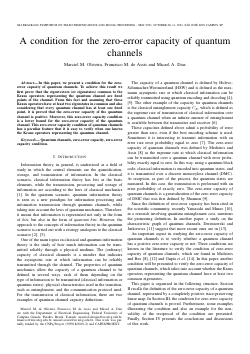
A condition for the zero-error capacity of quantum channels
Marciel Medeiros de Oliveira, Francisco M. de Assis, Micael Andrade Dias
DOI: 10.14209/sbrt.2023.1570917602
Keywords: Quantum channels Zero-error Capacity zero-error capacity condition
Abstract
In this paper, it is proved that the eigenvectors (or eigenstates) common to the Kraus operators representing the quantum channel are fixed points of it. From this and assuming that the Kraus operators that represent the quantum channel have at least two eigenstates in common, it is proved that the zero-error capacity of the quantum channel is positive. This error-zero capacity condition is a lower bound for the error-zero capacity of the quantum channel.Download
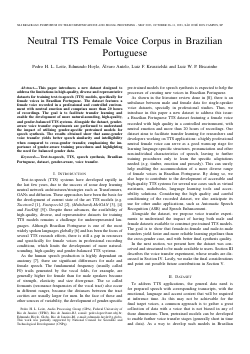
Neutral TTS Female Voice Corpus in Brazilian Portuguese
Pedro H. L. Leite, Edmundo Hoyle, Álvaro Antelo, Luiz F. Kruszielski, Luiz W. P. Biscainho
DOI: 10.14209/sbrt.2023.1570917697
Keywords: Text-to-speech Brazilian Portuguese dataset speech synthesis
Abstract
This paper introduces a new dataset designed to address the limitations in high-quality, diverse and representative datasets for training text-to-speech (TTS) models, specifically for female voices in Brazilian Portuguese. The dataset features a female voice recorded in a professional and controlled environment with neutral emotion and comprises more than 20 hours of recordings. The goal is to facilitate transfer learning and enable the development of more natural-sounding, high-quality, and gender-balanced TTS systems. Alongside the dataset, gender-aware voice transfer experiments are performed to understand the impact of utilizing gender-specific pretrained models for speech synthesis. The results obtained show that same-gender voice transfer yields better speech similarity and intelligibility when compared to cross-gender transfer, emphasizing the importance of gender-aware training procedures and highlighting the need for balanced gender data.Download
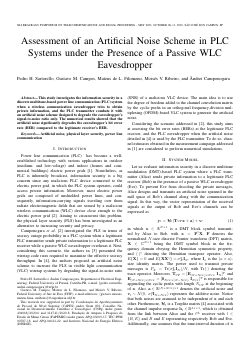
Assessment of an Artificial Noise Scheme in PLC Systems under the Presence of a Passive WLC Eavesdropper
Pedro Henrique Sartorello, Gustavo M Campos, Ândrei Camponogara, Mateus Filomeno, Moises Vidal Ribeiro
DOI: 10.14209/sbrt.2023.1570917740
Keywords: artificial noise physical layer security power line communication
Abstract
This study investigates the information security in a discrete multitone-based power line communication (PLC) system when a wireless communication eavesdropper tries to obtain private information and the PLC transmitter combats it with an artificial noise scheme designed to degrade the eavesdropper's signal-to-noise ratio only. The numerical results showed that the artificial noise significantly degrades the eavesdropper's bit error rate (BER) compared to the legitimate receiver's BER.Download
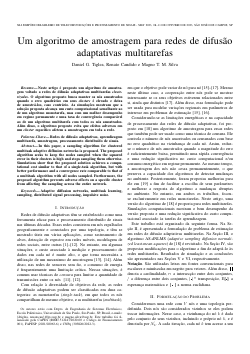
Um algoritmo de amostragem para redes de difusão adaptativas multitarefas
Daniel Tiglea, Renato Candido, Magno T. M. Silva
DOI: 10.14209/sbrt.2023.1570917956
Keywords: Redes de difusão adaptativas Aprendizagem multitarefa Amostragem Processamento distribuído de sinais
Abstract
Neste artigo é proposto um algoritmo de amostragem voltado a redes de difusão adaptativas multitarefas clusterizadas. O algoritmo proposto busca manter os nós amostrados quando o erro quadrático em seus clusters é elevado e deixa de amostrá-los, caso contrário. As simulações mostram que a solução proposta alcança um custo computacional semelhante ao de um algoritmo monotarefa, mas com um melhor desempenho em regime permanente e uma taxa de convergência comparável ao de um algoritmo multitarefa com todos os nós amostrados. Além disso, o algoritmo proposto evita que efeitos adversos em um cluster específico afetem a amostragem em toda a rede.Download
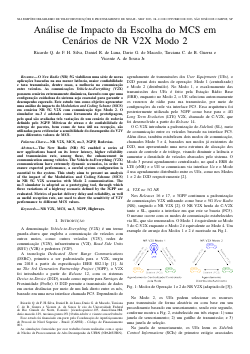
Análise de Impacto da Escolha do MCS em Cenários de NR V2X Modo 2
Ricardo Q. de F. H. Silva, Daniel R. de Luna, Dario G. de Macedo, Tarciana Cabral de Brito Guerra, Vicente Sousa
DOI: 10.14209/sbrt.2023.1570918152
Keywords: NR V2X MCS ns-3 Highways
Abstract
The New Radio (NR) 5G enabled a series of new applications based on its lower latency, higher reliability and transmission rate, among these, the improvement in communication between vehicles. The Vehicle-to-Everything (V2X) communications have extremely dynamic scenarios, in order to ensure expected performance, a careful system configuration is essential to the system. This study aims to present an analysis of the impact of the Modulation and Coding Scheme (MCS) in NR 5G V2X scenarios with Mode 2 communication. The ns-3 simulator is adopted as a prototyping tool, through which three variations of a highway scenario defined by the 3GPP are evaluated. Metrics of packet delivery delay and reliability, as well as useful reception rate, are used to show the sensitivity of V2V performance to different MCS values.Download